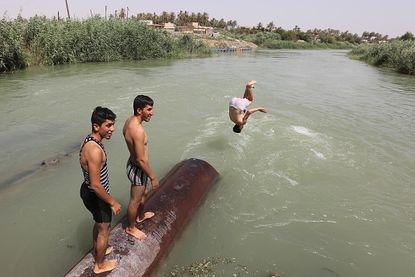Persian Gulf could experience 'intolerable' heat by end of the century


By 2100, parts of the Persian Gulf could experience heat and humidity so extreme that a person would not be able to survive being outside for several hours, researchers said.
In a study published Monday in the journal Nature Climate Change, Jeremy S. Pal of Loyola Marymount University and Elfatih A. B. Eltahir of MIT used climate models and a method of measuring atmospheric conditions known as wet-bulb temperature to determine how hot it would have to get for a person to sweat and still not cool off; they found that a wet-bulb temperature of 95 degrees Fahrenheit hits the mark (that's roughly the equivalent of a heat-index reading of 165 degrees Fahrenheit). After six hours of exposure, the conditions "would probably be intolerable even for the fittest of humans, resulting in hyperthermia," the researchers said.
Due to climate change, the coasts in the Middle East, where the water is already warm, would probably be the first to see these harsh combinations of heat and humidity, The New York Times reports. The 95-degree wet-bulb temperatures would likely happen once every 10 or 20 years, Eltahir said, and would be "quite lethal." Anyone without air conditioning or people working outdoors would suffer the most, as would people on the hajj, the pilgrimage that brings two million people to Mecca, Saudi Arabia, every year to pray outdoors. It takes place during different times of the year, and if it happened during an extremely hot summer, "this necessary outdoor Muslim ritual is likely to become hazardous to human health," the authors wrote. There is some hope, researchers say: If greenhouse gas emissions are reduced, "such efforts applied at the global scale would significantly reduce the severity of the projected impacts."
Subscribe to The Week
Escape your echo chamber. Get the facts behind the news, plus analysis from multiple perspectives.

Sign up for The Week's Free Newsletters
From our morning news briefing to a weekly Good News Newsletter, get the best of The Week delivered directly to your inbox.
From our morning news briefing to a weekly Good News Newsletter, get the best of The Week delivered directly to your inbox.
Sign up for Today's Best Articles in your inbox
A free daily email with the biggest news stories of the day – and the best features from TheWeek.com
Catherine Garcia has worked as a senior writer at The Week since 2014. Her writing and reporting have appeared in Entertainment Weekly, The New York Times, Wirecutter, NBC News and "The Book of Jezebel," among others. She's a graduate of the University of Redlands and the Columbia University Graduate School of Journalism.
-
 5 hilariously spirited cartoons about the spirit of Christmas
5 hilariously spirited cartoons about the spirit of ChristmasCartoons Artists take on excuses, pardons, and more
By The Week US Published
-
 Inside the house of Assad
Inside the house of AssadThe Explainer Bashar al-Assad and his father, Hafez, ruled Syria for more than half a century but how did one family achieve and maintain power?
By The Week UK Published
-
 Sudoku medium: December 22, 2024
Sudoku medium: December 22, 2024The Week's daily medium sudoku puzzle
By The Week Staff Published
-
 US won its war on 'murder hornets,' officials say
US won its war on 'murder hornets,' officials saySpeed Read The announcement comes five years after the hornets were first spotted in the US
By Peter Weber, The Week US Published
-
 Dark energy data suggest Einstein was right
Dark energy data suggest Einstein was rightSpeed Read Albert Einstein's 1915 theory of general relativity has been proven correct, according to data collected by the Dark Energy Spectroscopic Instrument
By Peter Weber, The Week US Published
-
 New DNA tests of Pompeii dead upend popular stories
New DNA tests of Pompeii dead upend popular storiesSpeed Read An analysis of skeletal remains reveals that some Mount Vesuvius victims have been wrongly identified
By Peter Weber, The Week US Published
-
 NASA's Europa Clipper blasts off, seeking an ocean
NASA's Europa Clipper blasts off, seeking an oceanSpeed Read The ship is headed toward Jupiter on a yearslong journey
By Peter Weber, The Week US Published
-
 Detailed map of fly's brain holds clues to human mind
Detailed map of fly's brain holds clues to human mindSpeed Read This remarkable fruit fly brain analysis will aid in future human brain research
By Peter Weber, The Week US Published
-
 The alarming rise of fake science
The alarming rise of fake scienceunder the radar Fraudulent papers are flooding scientific journals
By Devika Rao, The Week US Published
-
 Blind people will listen to next week's total eclipse
Blind people will listen to next week's total eclipseSpeed Read While they can't see the event, they can hear it with a device that translates the sky's brightness into music
By Peter Weber, The Week US Published
-
 Melting polar ice is messing with global timekeeping
Melting polar ice is messing with global timekeepingSpeed Read Ice loss caused by climate change is slowing the Earth's rotation
By Peter Weber, The Week US Published